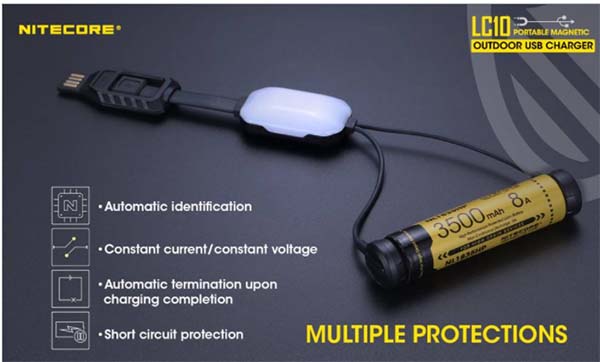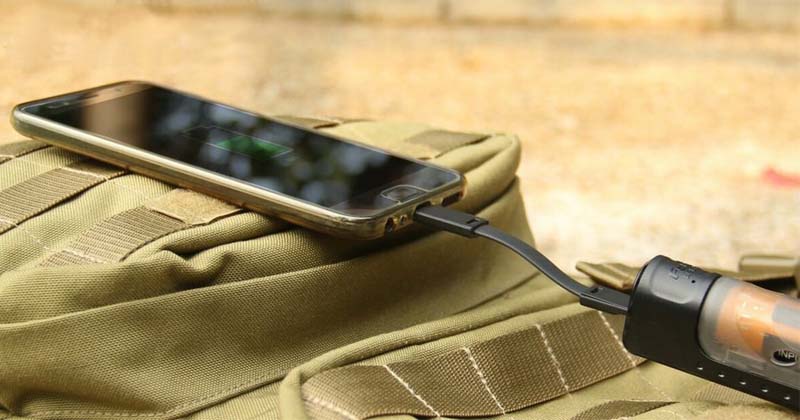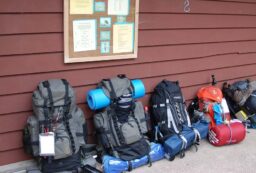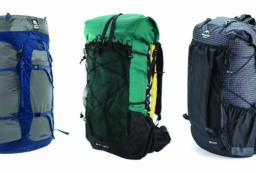There are now a lot of great ultralight power banks for backpacking. However, one interesting solution is to use 18650 batteries and use them as a power source. To make this work, you need a charger that also has discharging capabilities: then you can plug in your phone or other devices and charge them with the 18650 cells. You can also use 21700 and 26800 cells, though 18650 are the most popular.
What Are 18650 Batteries?
Technically called cells and not batteries, 18650 batteries are rechargeable lithium-ion batteries. They get their name because they measure 18mm x 65mm. Some newer 18650 batteries are actually a bit larger than this though.
Compared to standard rechargeable (NiMH-LSD) batteries, 18650 cells are much more power dense and thus lighter-weight. They also are also more efficient: in real-world situations, you are going to get more capacity with a 18650 than a NiMH-LSD battery.
18650 Batteries vs. Power Bank
Most power banks actually contain 18650 battery cells or other li-ion cells inside their casing. Thus, 18650 cells and power banks have a lot of similarities when it comes to performance. However, there are some important differences when it comes to backpacking.
Here’s how the pros/cons break down.
Pros of 18650 Batteries as a Power Source
Modular Solution
This is by far the biggest benefit of using 18650 batteries backpacking. The entire setup is very flexible. On weekend trips, you probably just need one 18650 cell. On long thru-hikes or situations where you have high power needs, bring as many cells as you need.
Weight
Power banks have gotten incredibly lightweight. The Anker 313, for example, has 10,000mAh of power at 7.52oz – which is 1,330mAh per ounce.
But it is still hard to beat the weight of a 18650 cell for ultralight backpacking.
A NiteCore 18650 3,500mAh cell weighs approximately 1.8oz. You’ll also need a charger plus cable, and that adds approximately 2oz to the setup.
Here’s how the weight breaks down:
- 1 cell + charger (3,500mAh )= 3.8oz = 921mAh per oz
- 2 cells + charger (7,000mAh) = 5.6oz = 1250mAh per oz
- 3 cells + charger (10,500mAh) = 7.4oz = 1418mAh per oz
- 4 cells + charger (14,000mAh) = 9.2oz = 1,521mAh per oz
- 5 cells + charger (17,500mAh) = 11oz = 1,590mAh per oz
- 6 cells + charger (21,000mAh) =12.8oz = 1,640mAh per oz
True, you do have to add in the weight of cables and a carrying case for the 18650 setup. However, you can use silicone sleeves for the cells (which weigh almost nothing) and you’d have to bring cables for a power bank too.
*Note that this definitely isn’t the lightest setup when it comes to mAh per oz. The NiteCore NB1000 Ultra Slim has 10,000mAh and weighs just 5.5oz – which is 1,887mAh per ounce. But that powerbank doesn’t have the same flexibility as using 18650 cells.
Cells Are Replaceable
All types of batteries – including 18650 cells and power banks – will eventually lose storage capacity over time. However, with 18650 cells, you have the ability to replace them as it happens. You can just bring a new 18650 battery on your trip.
This isn’t possible with power banks. The cells are soldered inside the pack. Unless you know how to hack the power bank, you won’t be able to easily remove the cells.
Device Compatibility
If you switch your lighting to 18650 cells, you will only have to worry about one type of battery. Yes, you could use a power bank to charge a USB headlamp – but you lose power when converting between different types of batteries. In this sense, using 18650 cells as your power bank and lighting battery is the most efficient solution.
Downsides of Using 18650 Batteries for Backpacking
Charging Time
The biggest downside of using 18650 cells when backpacking is the recharging time. They generally can only be charged at 0.5 to 1 amp input. By comparison, most good power banks recharge at 2.4 amps. They also recharge all the cells in the power bank at the same time. Unless you have a multi-slot charger (which will weigh more), you will have to charge each 18650 cell individually.
You generally need 3 to 6 hours to recharge one 3,500mAh 18650 cell. By comparison, the Anker 6,7000 power bank will recharge in 3 hours.
This isn’t really a big deal when going on weekend backpacking trips. But it is big drawback for thru-hikers who will you waste a lot of time sitting next to wall chargers in town. Keep in mind that it is often difficult to even find an available wall outlet on popular hiking trails.
Convenience
It is a lot easier to just bring a power bank with you when backpacking. With 18650 cells, you’ll need to keep track of which cells are discharged, charging times, and so forth. There can also be a lot more parts with a 18650 setup, such as cables, cases and adapters.
Cost
18650 cells are pretty pricy. Expect to pay $10 to $25 per cell depending on the capacity and features (some are high-performance, rated for cold-weather, etc.). You’ll also need the charger, which is another $10-$30. By comparison, you can get an ultralight power bank for $20 to$60.
Learning Curve
The final drawback of 18650 batteries for backpacking is the learning curve. It’s confusing as hell for newbies to figure out which type of 18650 cells to use, how to optimize the setup, how to daisy chain your flashlight and devices to charge them all at once… It might not be worth researching all of this just to save an ounce or two from your power setup.
Best 18650 Batteries and Charger/Power Banks
18650 batteries are expensive. So, it’s no surprise that there are a lot of fake 18650 batteries out there. These may work but have significantly reduced power capacity (you can tell because they will weigh less than real 18650 cells). Cheap 18650 cells also might not be protected and thus could spontaneously catch on fire (remember those Galaxy phones?).
The bottom line? Don’t waste money on cheap knockoffs. The same advice also applies to all types of batteries and power banks, though.
Right now the best 18650 cells are made by NiteCore and Fenix. The 3,500mAh cells weigh approximately 1.76oz (50 grams). Both brands make chargers with input/output, allowing them to work as power banks.
Lightweight 18650 Chargers with Discharging Function
There aren’t too many options when it comes to 18650 chargers that can also discharge. Nitecore used to make the LC10 charger (shown below) that weighed only 1oz. It has been discontinued. 🙁
Right now, these are your best options:
- Xtar SC1 Plus: 1.6oz (the Amazon weight is incorrect!)
- Fenix EdisonBright are-D1: 2.1oz. Has a digital display!

This sadly has been discontinued
Sources:
https://www.fenixlighting.com/blog/the-ultimate-guide-to-the-18650-battery/
https://backpackinglight.com/forums/topic/98746/
https://www.reddit.com/r/Ultralight/comments/8m589n/power_banks_are_heavy_and_i_hate_carrying_them/
https://backpackinglight.com/forums/topic/90896/
https://www.reddit.com/r/Ultralight/comments/816pwk/18650_ul_battery_pack_replacement_modular/
https://backpackinglight.com/forums/topic/battery-bank-for-charging-electronics/












5 Comments
John Schmidt
June 22, 2022 at 8:00 pmI have been using 18650 for longer backcountry trips to recharge my phone (for GPS navigation) as well as lighting. My problem is finding the right charging device.
The Fenix ARE-X11 left too much energy in the battery
The Nitecore F1 showed not functional (dead on arrival) and cost me the return postage and lots of hassle. (It also took my many months to get a warranty issue addressed on a Nitecore HC60 headlamp.)
The Nitecore LR60 acts as a charger, battery bank, and a lantern but it also leaves too much charge in the battery (compared to the Xtar).
The Nitecore F21i looks intriguing but I am hessitant to buy more Nitecore products.
Ideally, I would like an 18650 headlamp that doubles as a battery bank. I bought a handheld like for low cost on Amazon with a discharging feature but it does not work that well and I do not want to depend on it.
I use a XTAR-PB2S which works well but is a little heavy.
Any updates or advice would be useful.
Bill
October 10, 2022 at 9:42 pmWhy not use 21700 or even larger batteries for longer journeys?
Diane
October 12, 2022 at 11:56 amThose would also work. For me, 18650 are the ideal capacity and they seem to be most popular with other backpackers too. Plus, the smaller size means you can more precisely add more capacity. There’s no reason you couldn’t bring 21700s and 18650s, or some other mix and matching.
Roger
November 28, 2022 at 3:38 pmI carry 18650’s when hiking. The Nitecore F1 is my favorite powerbank using 18650’s as a source, but it is not longer produced, and I’m looking for a backup because these units seem fragile. I am settled on 18650s because they also drive my outstanding zebralight headlamp. The Fenix ARE-X11 is nice, but it charges my phone nearly twice as fast the F1 resulting in a lot of heat production, which may explain why the ARE-X11 only charges my phone a little more than half the percent as the F1.
Apparently nitecore replaced the F1 with the UL1, BUT according to what I read the UL1 can NOT be used as a battery bank.
The LC10 looks interesting and I just ordered it, but I expect that it will have a serious issue. When using as a battery bank on the trail, it will likely require my contriving some sort of way to ensure that the LC10 remains connected securely to the battery while in a pocket or backpack. This type of magnetic connector has not shown in my experience to be reliable when jostled around in a pocket.
When using a battery bank, I prefer individual batteries like 18650 as opposed to a dedicated battery bank. Batteries can fail, so with multiple individual batteries there can be a significant increase in reliability, at least this has proven true with things like ski boot heater batteries.
I just ordered a the klarus option, however, my old one failed.
More research required….
Diane
November 29, 2022 at 12:15 amThanks for the comment. I didn’t think about the failure aspect of power banks. That’s definitely another reason to go with multiple individual batteries… until the charger/device which turns them into a power bank fails!